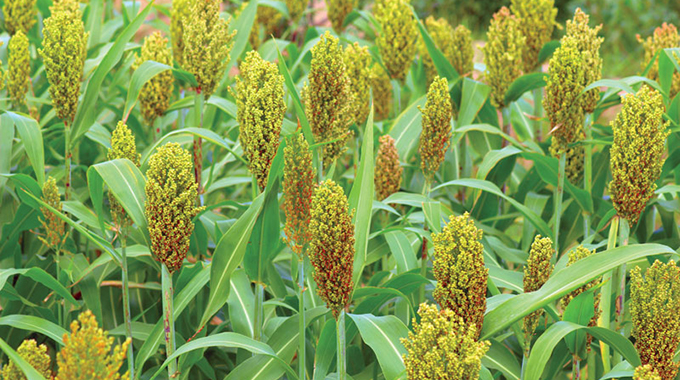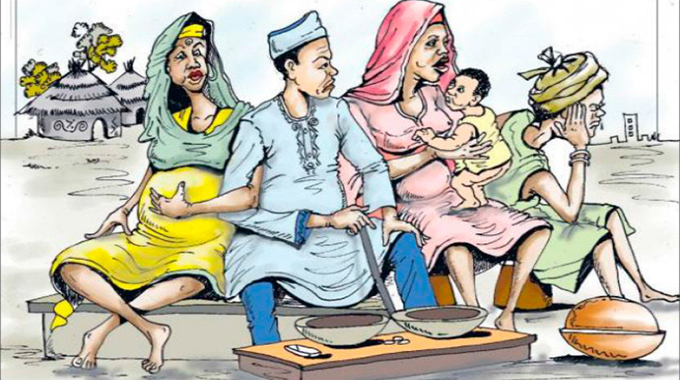Going against the grain with sorghum pays off for farmer

Rumbidzai Zinyuke
Manicaland Bureau
While hundreds of farmers in Buhera district are counting their losses this season because of the heavy rains that have washed away their crop, one farmer will be smiling all the way to the bank as his traditional grains are thriving.
Not only did he plant at the same time with the other farmers, he received the same amount of rainfall and probably applied the same amount of inputs.
But his crop is a head above the rest.
Mr James Garira from Ruvinga village says his half hectare plot of sorghum is looking good.
“We received good rains this year; at times it was too much,” he said. “We never went for more than a week without receiving rains. But as you can see, my crop has not suffered from the excessive water, it has actually thrived instead. I can chalk this down to good agricultural practices.”
Mr Garira said when the district received the first rains in November, he had already applied manure in his field, so he immediately planted.
He created contours at the edges of his field to improve drainage, a move which might have saved his crop.
“Our crop got good water and it is showing that we will have a good harvest,” said Mr Garira. “Although we received too much rain at some point, our crop was not affected because we dug drainage trenches at the end of the field so that it can hold the water when it rains.
“This means that the chances of flooding in the field also became slim as the water would seep into the field slowly during the dry periods.”
Buhera is prone to droughts and the district mainly has sandy soils which are also susceptible to leaching and water logging in seasons with above normal rainfall patterns like the one being experienced this year.
According to Manicaland Agritex head Ms Phillipa Rwambiwa, farmers in areas like Buhera who followed good agronomic practices were doing well despite the area being affected by the heavy rains.
“Some parts of the province with lighter soils have been affected by leaching and water logging,” she said. “However, the majority of the crop which is at tasseling and silking stage, is looking good.
“Farmers who managed to apply organic manure in areas with lighter soils like Buhera, have a good crop and we are advising them to take advantage of periods when the rain ceases to apply their top dressing.
“They should also create drainage channels to allow water to flow out of their fields and prevent leaching and water logging.”
And this is exactly what has saved Mr Garira’s crop.
He and nine other farmers in the area are contracted to grow sorghum by Delta Corporation for their Chibuku brand.
Although many other farmers who were on the programme stopped producing for the company due to poor prices, he says his family decided to continue.
The group of 10 gets inputs from Delta and after harvest, they sell their produce back to the company.
“My family and I love working in this field because it always gives us a good crop,” said Mr Garira. “This helps us to sustain ourselves and improve the lives of our families. If we tried to do maize, we might not be as successful because Buhera is a dry area and traditional grains fare better.”
Traditional grains have become an important cereal to ensure food security and mitigate against the impact of climate change.
The increased frequency of droughts, long mid-season dry spells and unreliable rainfall patterns have hit smallholder farmers hardest.
Over the years, traditional grains hectarage has been increasing gradually on the back of increased input support schemes and deliberate efforts to commercialise the grains which were only grown for back-up subsistence in the past.
Government, through the Pfumvudza programme, availed traditional grain seed to those who took part in the programme as a way of increasing production.
Buhera district Agritex officer Mr Simbarashe Sedeya said Buhera was best suited to traditional grains although many people now shun the crop.
He said farmers who had planted traditional grains this season were better off than others.
“Traditional grains are best here in Buhera,” said Mr Sedeya. “The martia variety of sorghum and pearl millet particularly do well here although some people do not like growing pearl millet because it is labour intensive. If we really look at it, this is where the people will get harvest this season.”
For farmers like Mr Garira, taking up more traditional grains would not be a challenge if they had more support.
“We can put more of our fields under traditional grains but we do not have the capacity for now. We lost most of our cattle to disease and drought last year so we cannot plough the fields. Putting Pfumvudza plots would require more labour but it might work for us,” he said.
Agricultural experts estimate that 80 percent of arable land in Africa has low soil fertility and suffers from physical soil degradation as a result of massive nutrient loss caused by unsustainable soil management practices.
Nitrogen is responsible for crop growth and yields obtained in agricultural production.
It is also the most limiting nutrient to plant growth in smallholder farms in Africa due to its susceptibility losses resulting from leaching and run-off or erosion, among other factors.








Comments